|
archive file describing:
|
|
<Piperola> version 1.0 Godfried-Willem RAES
1998-2003 |
Module 2: 'Piperola'
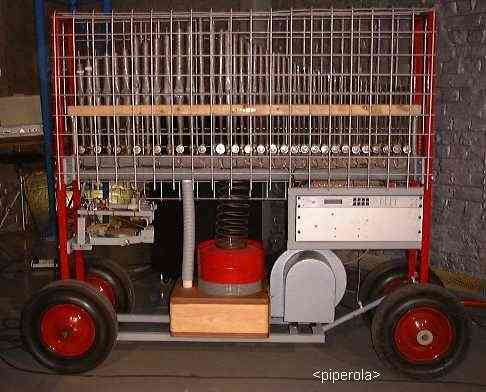 A second register module,
named the 'Piperola', was finished in july 1998, and made its first official
public appearance in my street opera production 'Rednick'. On saturday 20th
of june, however, the module played its first -then out of tune- scale... This
module uses 2"-flute register pipes, recycled from the same old organ from
which we recycled the 'Vox Humana' pipes used for the <Vox Humanola> module.
The original register was labeled 'Octavin'.
A second register module,
named the 'Piperola', was finished in july 1998, and made its first official
public appearance in my street opera production 'Rednick'. On saturday 20th
of june, however, the module played its first -then out of tune- scale... This
module uses 2"-flute register pipes, recycled from the same old organ from
which we recycled the 'Vox Humana' pipes used for the <Vox Humanola> module.
The original register was labeled 'Octavin'.
The register consists of 49 metal flue-pipes in the range 60 to 108 (midi-notes as reference). The notes 60 to 71 use stopped lead-pipes (modified waldfloete), in order to save in size, whereas the notes 72 to 108 use open flue pipes. The pipes stand freely on the valves, held in place by a thick wooden pipeholder. The module is fully polyphonic.
The open pipes can be tuned with a small slit in the upper end of the pipes, whereas the stopped pipes have a slidable cap covering their end. Instead of the usual paper, teflon is used to make the slides airtight. Teflon came out to be a by far superior material in these applications than the more traditional stuff, blue paper.
The wind is provided by a Laukhuff 'Ventus'-type radial compressor working on a variable (under computer controll) 95mm WK windpressure. The windchest is a welded steel construction and uses modified industrial M&M solenoid valves with orifices of 4mm diameter. The achors have been shortened a bit (1mm) and at their bottom end covered with felt. Furthermore, the tension of the return spring was halved by cutting of 3 turns of the helical spring and stretching it again after this operation. For the notes 60 to 71 we drilled out the valves to a diameter of 5mm, since the stopped pipes needed more wind. In 2003 we added the 3-phase pulse width modulation controll circuit for the compressor as well as a heavy duty solenoid pushing the bellows, making a wide variety of dynamic variations and articulation possible on this automat. (see technical notes at the very end of this page).
As a little extra feauture, we added a mechanical drum-playing machine ('Turkish Music'), mapped
to the highest midi notes 120-127, as well as the vibrato mechanism.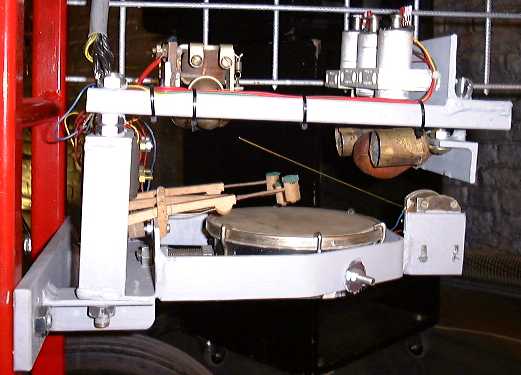
The entire piperola module is mounted on 4 large wheels and thus is very transportable. To prevent people from touching the pipes and eventually detuning them, we covered the entire windchest with pipes with a welded metal cage. Not the utmost beauty, but highly effective...
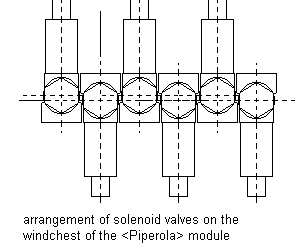

| Back to Logos-Projects page : projects.html | Back to Main Logos page:index.html | To Godfried-Willem Raes personal homepage... | To Instrument catalogue |
Module 2: <Piperola>
 Dit register loopt van midi noot 60 tot en met 108. De
opbouw maakt gebruik van ventielen met een doorlaat van 4mm gemonteerd op een
enkele windlade. Omwille van de kompaktheid werden de ventielen om en om gemonteerd,
zoals blijkt uit de technische tekening hiernaast. De afstand tussen de aslijnen
van beide rijen boorgaten is 8mm, zodat de bronzen behuizingen van de ventielen
in elkaar kunnen haken. De minimale afstand tussen de aslijnen van de ventielen
onderling is 20mm. Uiteraard, wordt deze maat groter wanneer de diameter van
de in te zetten pijpen groter wordt dan deze minimale maat. (Zie tabel). De
gebruikte ventielen zijn van het type M&M C249DBL, omgebouwd zoals uitvoering
beschreven bij de <Vox Humanola> module. We gebruikten voor de noten 71
tot 108 pijpen uit een register genaamd 'Octavin 2'. De lagere (noten 60 tot
70) werden ontnomen aan het Waldfloete register (roerpijp), maar gemodificeerd
door de pijpen volledig te dekken. Door deze ingreep kon ook de bouwhoogte worden
beperkt. De oorspronkelijke smalle buisjes op het deksel van de pijpen werden
verwijderd en de potdeksels dichtgemaakt. De afdichting tussen pijp en afsluitdeksel
-traditioneel steeds uitgevoerd met een speciaal soort blauw papier- voerden
we uit in het moderne en heel wat duurzamer materiaal Teflon. Dit komt de stemvastheid
van deze pijpen ook aanzienlijk ten goede. Voor deze pijpen bleek het nodig
de ventielen iets uit te boren. 5mm leek nog net haalbaar. Om turbulenties op
te vangen in de pijpvoet, werd de uitlaat van deze ventielen bovendien ook konisch
uitgeboord.
Dit register loopt van midi noot 60 tot en met 108. De
opbouw maakt gebruik van ventielen met een doorlaat van 4mm gemonteerd op een
enkele windlade. Omwille van de kompaktheid werden de ventielen om en om gemonteerd,
zoals blijkt uit de technische tekening hiernaast. De afstand tussen de aslijnen
van beide rijen boorgaten is 8mm, zodat de bronzen behuizingen van de ventielen
in elkaar kunnen haken. De minimale afstand tussen de aslijnen van de ventielen
onderling is 20mm. Uiteraard, wordt deze maat groter wanneer de diameter van
de in te zetten pijpen groter wordt dan deze minimale maat. (Zie tabel). De
gebruikte ventielen zijn van het type M&M C249DBL, omgebouwd zoals uitvoering
beschreven bij de <Vox Humanola> module. We gebruikten voor de noten 71
tot 108 pijpen uit een register genaamd 'Octavin 2'. De lagere (noten 60 tot
70) werden ontnomen aan het Waldfloete register (roerpijp), maar gemodificeerd
door de pijpen volledig te dekken. Door deze ingreep kon ook de bouwhoogte worden
beperkt. De oorspronkelijke smalle buisjes op het deksel van de pijpen werden
verwijderd en de potdeksels dichtgemaakt. De afdichting tussen pijp en afsluitdeksel
-traditioneel steeds uitgevoerd met een speciaal soort blauw papier- voerden
we uit in het moderne en heel wat duurzamer materiaal Teflon. Dit komt de stemvastheid
van deze pijpen ook aanzienlijk ten goede. Voor deze pijpen bleek het nodig
de ventielen iets uit te boren. 5mm leek nog net haalbaar. Om turbulenties op
te vangen in de pijpvoet, werd de uitlaat van deze ventielen bovendien ook konisch
uitgeboord. 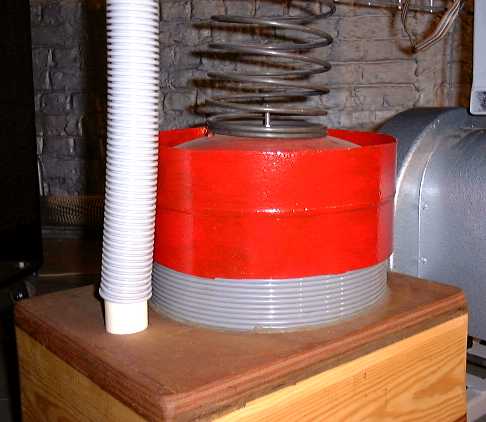
De pijpen rusten rechtstreeks op de ventielen en worden op hun plaats gehouden door een houten pijphouderplank waarin de pijpen op 2/3 van hun voetlengte (205mm) vastzitten. Voor de afdichting tussen ventiel en pijp gebruikten we, al naar gelang de diameter van de pijpvoet, rubber of bijenwas, zoals gebruikelijk voor de montage van de doorslaande tongen in akkordeons. Zoals we in de <Vox Humanola> module castagnetten toevoegden, zo voorzagen we hier in een klein automatisch trommelspeelwerk. De verwijzing naar de 'Flute et Tabor' kombinatie uit de oude volksmuziek is daarmee kompleet. Zoals in de <Vox Humanola> werden ook hier de perkussiegeluiden gemapt op het midi nootbereik 120 tot 127.
Een heuse tremulant, waarvoor gebruik gemaakt werd van een zware elektromagneet die op de blaasbalg duwt, werd toegevoegd en afgewerkt in 2003. In datzelfde jaar werd ook de pulsbreedte besturing van de motor, en daarmee dus van de winddruk, afgewerkt. De besturing van de winddruk maakt gebruik van de midi noten 0 tot 6, terwijl met noot 7 (de diepe G), de elektromagneet in werking kan worden gesteld. Deze toevoeging maakt niet alleen het effekt van een tremulant mogelijk, maar laat eveneens toe noten van echte en kontroleerbare dynamische aksenten te voorzien. Op elk inzet van een noot waarop een sfz aksent gewenst is, moet dan tevens noot 7 worden meegespeeld, maar dan wel met hele korte duur-waarden.
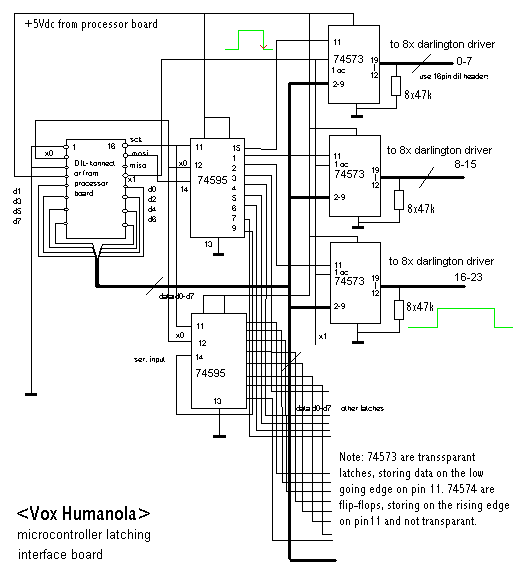 Ook
de elektronische sturing werd uitgevoerd zoals in deze module. Van de eerste
demultiplexer chip ( de74HC595) gaat de uitgang van pin 15 (O0), gemapt op midi
noten 0 tot 7 naar de stuurschakeling voor de kompressor terwijl voorts alleen
nog de uitgang op pin 7 (O7) gebruikt wordt en wel voor de midi noten 60 tot
63. De sturing van de andere noten vertrekt dan van de O0 tot O5 uitgangen van
de tweede 74595 chip (pinnen 15, 1,2,3,4,5). Pin 6 (O6) wordt niet gebruikt,
terwijl pin 7, gemapt op de midi noten 120 tot 127 instaat voor de aansturing
van het slagwerk.Het schema hiernaast is voorts identisch met dat van de <Vox
Humanola>. In plaats van de in het schema vermelde darlington transistoren,
werden hier evenwel power mosfets toegepast. We gebruikten het Harris Semiconductor
type RFL2N05L. De 16-pins dil konnektor wordt aangesloten op een mikroprocessor
board (de motorola 6805 wordt hiervoor ingezet) uit de reeks van het Amerikaanse
bedrijf Pavo.
Ook
de elektronische sturing werd uitgevoerd zoals in deze module. Van de eerste
demultiplexer chip ( de74HC595) gaat de uitgang van pin 15 (O0), gemapt op midi
noten 0 tot 7 naar de stuurschakeling voor de kompressor terwijl voorts alleen
nog de uitgang op pin 7 (O7) gebruikt wordt en wel voor de midi noten 60 tot
63. De sturing van de andere noten vertrekt dan van de O0 tot O5 uitgangen van
de tweede 74595 chip (pinnen 15, 1,2,3,4,5). Pin 6 (O6) wordt niet gebruikt,
terwijl pin 7, gemapt op de midi noten 120 tot 127 instaat voor de aansturing
van het slagwerk.Het schema hiernaast is voorts identisch met dat van de <Vox
Humanola>. In plaats van de in het schema vermelde darlington transistoren,
werden hier evenwel power mosfets toegepast. We gebruikten het Harris Semiconductor
type RFL2N05L. De 16-pins dil konnektor wordt aangesloten op een mikroprocessor
board (de motorola 6805 wordt hiervoor ingezet) uit de reeks van het Amerikaanse
bedrijf Pavo.

Het schakelschema voor de PWM motor besturing en de tremulant is hierboven weergegeven. De source kode voor de BS1 basic stamp kan je downloaden door deze link te klikken.
De piperola module wordt in tessituur gekomplementeerd door <Bourdonola>, die het gebied van 36 tot 62 dekt. In deze kombinatie beschikken we over een instrument met volle 6 oktaven tessituur.
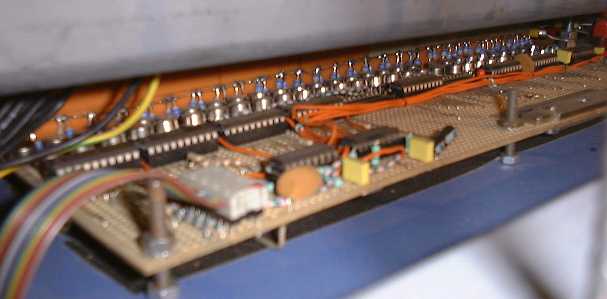
Gedetailleerde dimensionering voor de bouw van de Piperola register module:
 Ter beperking van de bouwhoogte en vooral omwille van de transporteerbaarheid
werden voor het laagste oktaaf tinpijpen, (midi noten 60 tot 70) half gedekte
pijpen gebruikt.
Ter beperking van de bouwhoogte en vooral omwille van de transporteerbaarheid
werden voor het laagste oktaaf tinpijpen, (midi noten 60 tot 70) half gedekte
pijpen gebruikt.
hartafstanden boorgaten ventielen, diameters van de pijpen
| windlade hoog (49 pijpen, 4 oktaven)
pijpdiameter na labium/ boorafstand |
pijplengte vanaf labium |
| Gedekt (van hoog naar laag) | |
|
|
| Open (van laag naar hoog) | |
|
|
| Oppervlakte doorlaat windlade>615mm2 | |
| Diameter windvoorziening windlade>28mm |
Maximale werkingsdruk in diverse gangbare eenheden:
Maximaal luchtverbruik per windlade (bij klusters):
Piperola is equiped with a small percussion section, mapped on the midi note range 120 to 127. The mechanism uses solenoids removed from old Revox G36 taperecorders. Each recorder has two 24V/300mA solenoids and a single 24V/100mA solenoid. They are very nicely finished and very reliable.
 We used parts from old upright pianos to realize the
mechanism to strike the percussion instruments. Midi notes 120 and 121 strike
a small drum with a strong attack. These should be used in alternation for fast
rolls. Midi note 122 strikes the same drum, but at a much softer level (herefore
we used the 100mA solenoid) and in the center of the small drum. A rimshot,
mapped on midi note 123, was realized using a rotational solenoid driving a
long brass rod striking the drumskin parallel to its surface. Slit bells sound
when midi note 124 is played, We mounted 6 bells on the moving part of a strong
pre world war two relais. Notes 125 and 126 strike very small oxenbells whilst
note 127, finally, strikes gently a very high pitched chinese templeblock. This
percussion section forms a module of its own in the Piperola. It was mounted
under the windchest and can easily be removed for maintenance and repair.
We used parts from old upright pianos to realize the
mechanism to strike the percussion instruments. Midi notes 120 and 121 strike
a small drum with a strong attack. These should be used in alternation for fast
rolls. Midi note 122 strikes the same drum, but at a much softer level (herefore
we used the 100mA solenoid) and in the center of the small drum. A rimshot,
mapped on midi note 123, was realized using a rotational solenoid driving a
long brass rod striking the drumskin parallel to its surface. Slit bells sound
when midi note 124 is played, We mounted 6 bells on the moving part of a strong
pre world war two relais. Notes 125 and 126 strike very small oxenbells whilst
note 127, finally, strikes gently a very high pitched chinese templeblock. This
percussion section forms a module of its own in the Piperola. It was mounted
under the windchest and can easily be removed for maintenance and repair.
The notes from 36 to 62 can be complemented to piperola by combining the automat with our <Bourdonola> module, thus forming a full 6 octave instrument.
Piperola expression mechanism (added, may 2003)
The compressor power can be controlled using midi note-on note-off commands. The note range used to this end is: 0 to 6. As soon as note 6 (low F#) is output, the compressor will run at its full power. When note 6 is off, gradual control is possible using notes 0-6. Note 0 should be interpreted a the LSB of the controll number, whereas note 6 is the MSB. Note that, when no note-on commands in the range 0-6 (low C to F#) are received, the motor will not be switched on and consequently, you will not hear anything happening...
The heavy duty solenoid mounted on the bellows can serve two distinct purposes:
1.- as a tremulant: you should send note-on and note-off commands for note 7 (low G) in a periodic rate. The period should be taken between 0.5 and 8 Hz. This will cause a vibrato on all notes playing.
2.- as a real 'velocity' attack controller. In this case you double each note to be played with a short low G (midi note 7), say a sixteenth or so. The note off for this note should come earlier than the note(s) off for the notes to be played with an accent.
| (Terug) naar logos-projekten: | Terug naar Logos' index-pagina: | Naar Godfried-Willem Raes personal homepage... | Naar katalogus instrumenten |
The <Piperola> automat can be heard on the Logos Public Domain CD <Automaton> (LPD007). <Piperola> also is a fixed member of the <M&M> robot orchestra, and as such can be heard on the Logos Public Domain CD <M&M> as well.
Last update: 2005-01-27 by Godfried-Willem Raes